This was published 5 years ago
Italy's coronavirus 'red zone' springs a leak
In a very Italian way, the man-made dam wall designed to hold back the virus from spilling over into Europe is already cracking.
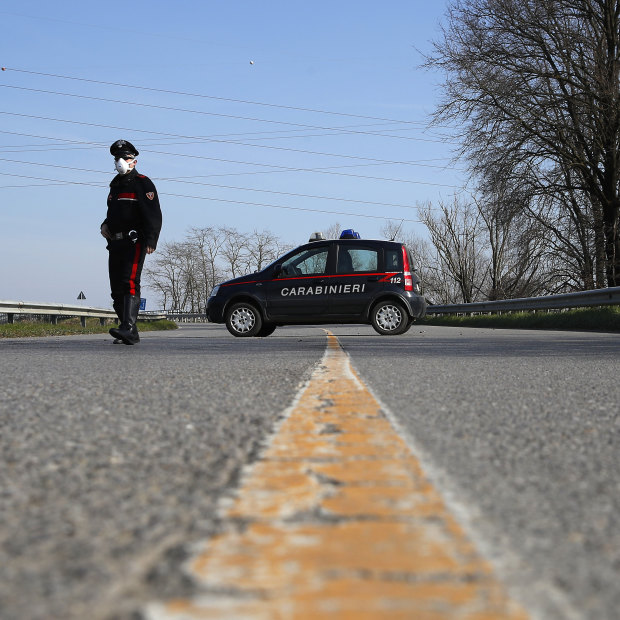
A sole Carabinieri officer at a checkpoint near Codogno, one of dozens of similar roadblocks set up in northern Italy. Credit: AP
On the outskirts of Zorlesco, a small town in Italy's north, Luigi Malabarba is living on the frontline of the coronavirus outbreak - literally.
Police cars swooped in on Monday and a handful of officers wearing facemasks and plastic gloves jumped out and set up a roadblock right outside his home. On one side of the cordon is the so-called red zone, a cluster of 10 villages supposedly quarantined from the rest of the country. On the other side, there is unrestricted freedom and some sense of normalcy in the midst of a highly abnormal situation in a sleepy slice of regional Italy.
Malabarba is grateful for the effort to contain the worst outbreak of coronavirus outside Asia, even though it forced the local hospital to cancel his surgery, scheduled for Tuesday. His biggest question at this point is whether he's even in the quarantine zone or not.
"Living here on the frontier, I don’t know if I'm meat or fish, if I'm healthy or sick," he laughed.
Billed as a tough but necessary measure to halt the spread of the virus, Italy threw up dozens of roadblocks in the wealthy Lombardy region on Monday after the number of confirmed cases exploded over the weekend. People weren't allowed to leave and anyone who wanted to go in needed to prepare to spend at least two weeks inside. The quarantine of 50,000 people made global news and the Italian government used it to reassure nervous European leaders that the problem was under control.
But the man-made dam wall designed to hold back the virus from spilling over into Europe is seriously leaking.
When cars approached the checkpoint on Tuesday, many drivers were waved in or out. Some - but not all - flashed various paperwork. One woman refused entry became enraged and an animated argument began that ended with her threatening to "wring the necks" of police officers. At one point, a teenager on a bicycle appeared in the distance, made his way up Zorlesco's main street and pedalled straight through the cordon unchallenged. Another man in a red tracksuit walked up the sealed-off street and after a brief but forceful discussion with police was allowed to leave. Most weren't wearing face masks.
"People aren’t that worried," Malabarba said. "They are not wearing masks here."
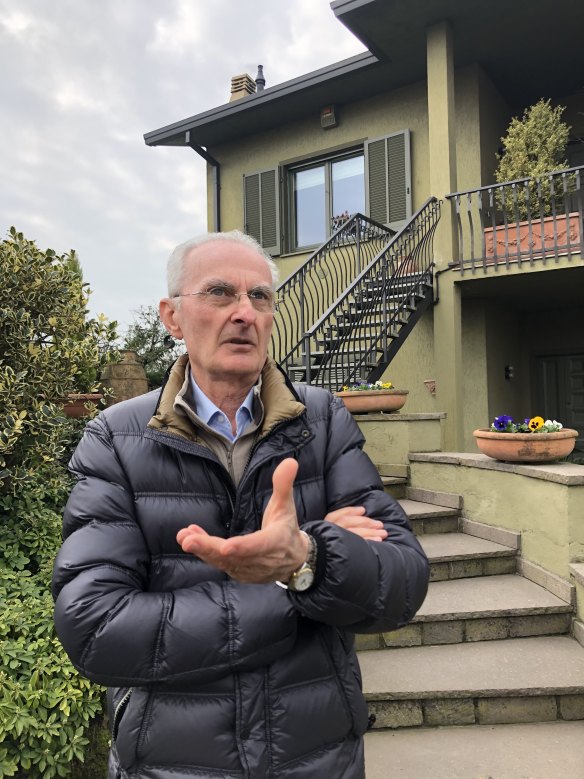
Luigi Malabarba outside his home on the edge of the quarantine zone in northern Italy. Credit: Bevan Shields
There are signs China is limiting the rate of new coronovirus infections, in stark contrast to the unfolding situation near Milan. In just days, the number of cases skyrocketed from three to more than 200. And in the space of 24 hours, it jumped more than 100 to reach 322 on Tuesday (Wednesday Australian time). Worryingly, some of the new cases were reported in areas away from the north including Sicily, Tuscany and Liguria.
Italian health authorities are still searching for 'patient zero' - the person who brought the virus to northern Italy and could solve the mystery of how it spread so rapidly and whether more outbreaks are likely. There is concern the person is still travelling around Italy or Europe, potentially infecting more people who are yet to display symptoms.
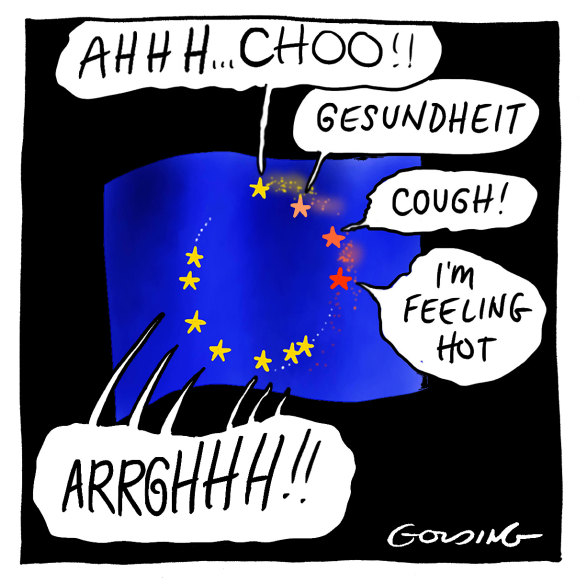
Illustration: Matt GoldingCredit:
Initially, authorities believed the culprit was a 38-year-old-man identified only as 'Mattia'. He ran a half-marathon, played football and socialised with mates before presenting to hospital in the city of Codogno feeling unwell, only to be turned away. By the time he returned and was treated, his pregnant wife and several hospital staff and patients had caught it from him. However Mattia had not recently been to China, nor been in contact with anyone who had been in affected areas in Asia. The search continues but patient zero may never be found.
The roadblocks were designed to limit the spread of the virus into the rest of Italy, particularly nearby Milan, the country's financial headquarters and home to 1.4 million people. The porous quarantine borders less than an hour away, covering cities with a fraction of the population of Milan, is strong evidence that Italy does not have the stomach to match China's controversial but highly effective authoritarian response to the outbreak where it originated in the densely populated Wuhan province.
It's also hard to envisage any other European nation matching China's hardline approach.
World Health Organisation assistant director general Bruce Aylward has just completed a mission to China and believes the world could learn from its rapid response and "extraordinary mobilisation".
"China knows how to keep people alive," Aylward said.
"It is staggering. Every person you talk to there has a sense of responsibility, they are mobilised like in a war against this virus."
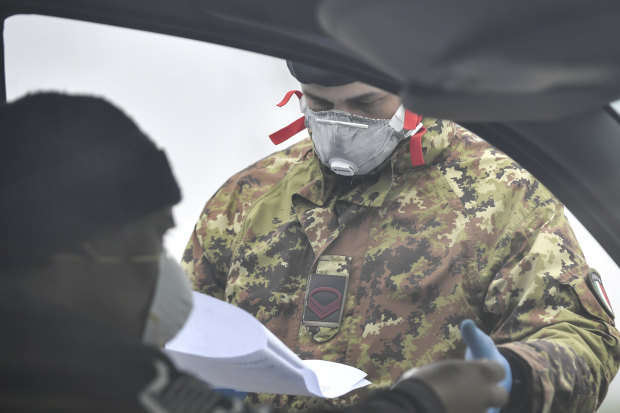
An Italian Army soldier checks paperwork at a cordon in Italy's north.Credit: LaPresse
Italian Prime Minister Giuseppe Conte blasted Codogno's hospital for dealing with the 'Mattia' case in a way that "wasn't completely proper according to the protocols that are recommended for these cases" - a reference to the man being turned away despite apparently showing flu-like symptoms.
"This surely contributed to the spread," Conte told reporters in Rome.
But Lombady's health chief Giulio Gallera hit back and said the man presented no risk factors associated with the virus when he first visited the emergency department. The delay between infection and signs of symptoms is one of the trickier challenges of dealing with COVID-19.
Italy's changing approach to dealing with the virus has also caused confusion. Having initially had a policy of testing anyone who had contact with an infected person, the new containment strategy is less strict and focussed on self-quarantine and regular temperature testing.
Only if they develop symptoms are they tested, most often by a team performing house calls to prevent hospitals and clinics being overly stressed, Elia Delmiglio, the mayor of Casalpusterlengo, one of the 10 towns in Lombardy's red zone, told AP.
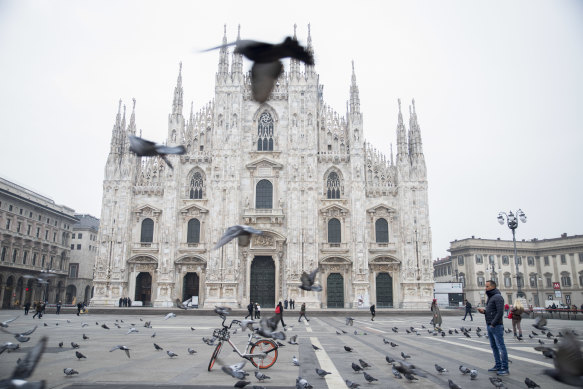
Milan's Piazza del Duomo is normally packed with residents and tourists but the effects of coronavirus are being felt. Credit: Bloomberg
Meanwhile, the Italian government has issued an emergency decree giving it sweeping power to ban access to any area of the country; suspend demonstrations, events and meetings even in private places; close schools, universities, museums and churches, place infected people under active surveillance, close private businesses, and make the use of personal protective equipment a condition of entry to shops, transport and essential public services.
Inside the quarantine zone, the streets are already empty and supermarkets running low. Supplies are being trucked in and paramedics dressed in highly protective suits are coming in and out to treat infected residents.
While waiting on the edge of the red zone, The Sydney Morning Herald and The Age spotted someone in a paddock well outside the police roadblock. The man, Giuseppe Mascheroni, had simply walked out of Zorlesco through its flat agricultural fields.
"I am retired. I am home anyway so it's not a problem for me," Mascheroni said. "It’s a bit annoying to be stuck at home but I am taking advantage of the quiet time.
"The atmosphere seems quite surreal." He waved goodbye and walked back home.
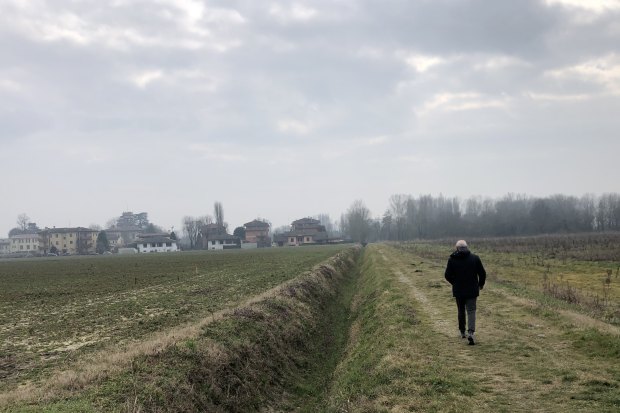
Giuseppe Masheroni walks back to the town of Zorlesco. Credit: Bevan Shields